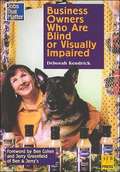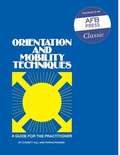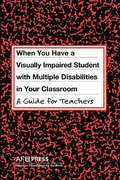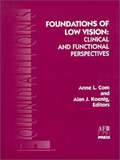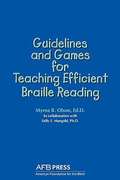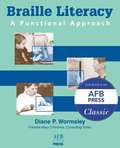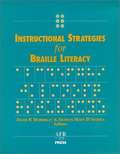Special Collections
American Foundation for the Blind
Description: American Foundation for the BlindPress offers a wide range of information for students, professionals, researchers, and blind and visually impaired people and their families. #teachers #disability
- Table View
- List View
The Conquest of Blindness
by Henry Randolph LatimerThe term "Conquest of Blindness" is taken to include any preventive, remedial, educational, rehabilitating, or relief phase of work pertaining to the handicap of blindness.
The primary aim of the volume is to lift work for the conquest of blindness out of the miasma of alms and asylums into the more wholesome atmosphere of social adjustment.
Other aims of the volume are to serve as a supplementary text for the use of the profession, and as an incentive to the chance reader to delve more deeply into the subject, and to present as modestly as may be the autobiography of one blind person who has contributed in small measure toward the conquest of blindness.
What of the Blind? A Survey of the Development and Scope of Present-Day Work with the Blind
by Helga LendeThis book is intended as a companion volume to What of the Blind? Recently published by the American Foundation for the Blind. The first volume was brought out in answer to a long-felt need for a convenient reference work to put in the hands of professional workers, board members and lay persons desiring general information on work with the blind. The subjects treated were mainly of a general nature as will be seen from the table of contents appended to this book.
The Demography and Causes of Blindness
by Hyman GoldsteinA report on the statistics of blindness from an international point of view.
Ability Structure and Loss of Vision
by Jyrki JuurmaaPsychological testing of the ability structures of the blind and sighted was commenced almost simultaneously during the first decades of this century. However, a majority of the studies concerning the blind, and the most crucial among them, sought to develop IQ-type test batteries, intended mainly for appraising their school achievement. By contrast, systematic studies have not been carried out to explore the relationships among different, mutually relatively independent traits and the quantitative contributions of such traits to different test performances. This lack of interest is perhaps due to the narrow range of occupations regarded as suitable for the blind: there has been no acute need for a more differentiated picture.
Manual for the Stanford Multi Modality Imagery Test
by William L. DautermanThe author's data on the test called "The Stanford Multi-Modality Imagery Test for the Blind" as a part of a research project has been revised in this manual under the name of "The Stanford Multi-Modality Imagery Test."
Images of Blind and Visually Impaired People in the Movies, 1913-1985
by Wendy Erickson and Diane WolfeListed in this book are the titles and other information about movies that include characters who are blind or visually impaired.
Business Owners Who Are Blind or Visually Impaired
by Deborah KendrickThe second title in the exciting Jobs That Matter series written by an award-winning blind journalist, Business Owners Who Are Blind or Visually Impaired demonstrates the wide range of careers and talents that can be pursued by persons with visual impairments. Each profile features a successful individual who has accomplished his or her dream of business ownership and who shares important insights. From a lawyer and an accountant to a florist and a gourmet cook, the range of engaging stories told will inspire young adults with visual impairments and the parents, teachers, and counselors who advise them.
The Community of the Blind
by Yoon Hough KimDr. Kim has investigated the validity of the widely-held view that while there are a large number of blind persons whose social lives are centered in the mainstream, that is with sighted persons, there are an equally large number of blind persons whose social lives are restricted mainly to other blind persons.
Orientation and Mobility Techniques
by Everett W. Hill and Purvis PonderA large-format manual covering definitions, techniques, and devices, designed for administrators, educators, rehabilitation counselors, and other professionals concerned with the mobility training process. A classic compilation of information on an essential subject.
Sex Education for the Visually Handicapped
by American Foundation for the BlindSexuality is at present very much in the spotlight. It is stressed over and again by educators and child psychiatrists how important a good sex education is for the optimum development of the child.
The Blind in School and Society
by Thomas D. CutsforthThe purpose of this book is to help acquaint the seeing with the blind and the blind with themselves.
When You Have a Student with Visual and Multiple Disabilities in Your Classroom
by Jane N. Erin and Susan J. SpunginAs a special educator, a classroom teacher, or an educational team member, you may be working with a visually impaired student for the first time or as an experienced professional. This booklet provides information on how visual impairment affects learning in communication, movement, self-care skills, and other important areas, and on how to work effectively with students who have visual and other disabilities.
Toward Independence
by Anne YeadonThis book is an introduction to the use of instructional objectives in the teaching of severely visually impaired persons. While it happens to use a daily living skills course as an example of how a teacher might develop a course around this educational method, it is not a daily living skills teaching manual. A creative teacher should be able to adapt the approach as described in Toward Independence to many other subjects.
Foundations of Low Vision
by Alan J. Koenig and Anne L. CornThis text explains in great detail how to do low vision exams, the principles behind magnifiers and other forms of magnification, and much more.
The Profession of Orientation and Mobility in the 1980s
by Mark M. Uslan and Everett W. Hill and Alec F. PeckThis book is a report of two national studies to compile descriptive statistical information about the demographic trends that will influence the future of the O&M profession--one conducted in 1983 and the other in 1985.
Hand in Hand
by Elga Joffee and Jeanne Glidden Prickett and Therese Rafalowski Welch and Kathleen Mary HuebnerThis series was designed to develop resources for educators of children who are visually impaired, hearing impaired, and severely disabled. The Hand In Hand materials emphasize the communication and mobility skills crucial to independence, and provide important information to help service providers do their jobs effectively. Containing contributions from more than 30 nationally recognized experts in the field of deaf-blindness, this groundbreaking information consists of four components that can be used separately or together. A two-volume, self-study text that explains how deaf-blind students learn, focusing on essential communication and mobility skills. Designed to provide comprehensive information in an easy-to-read way, this invaluable resource includes identified key concepts, self-study questions and answers, and references. The user-friendly format includes concise "Help at a Glance" and "From Theory to Practice" sections throughout. Sidebars, figures, tables, graphs, and photos offer additional perspectives and information.
What of the Blind? A Survey of the Development and Scope of Present-Day Work with the Blind
by Helga LendeWhat of the Blind? is designed with a view to presenting in one single volume the experience and opinions of leaders in this specialized field. The material has been grouped so that the student may easily find the aspect of the subject in which he is especially interested. Following each chapter is a short reading list which will serve as a guide to further study.
HIV/AIDS Prevention
by Judy Matsuoka and Christine E. Pawelski. and Gaylen KappermanThis manual is designed to help rehabilitation teachers, educators, and other practitioners who work with blind and visually impaired persons provide their clients with the facts they need to deal with the issues concerning HIV/AIDS.
Guidelines and Games for Teaching Efficient Braille Reading
by Myrna R. Olson and Sally S. MangoldThese unique guidelines and games provide ideas for adapting a general reading program to the needs of braille readers and enriching early instruction in braille that are based on research in the areas of rapid reading and precision teaching. Classroom teachers and anyone working with children who are blind or visually impaired will find this classic handbook an invaluable resource.
Braille Literacy
by Diane P. WormsleyWormsley (program director, Professional Preparation Program in Education of Children with Visual and Multiple Disabilities, Pennsylvania College of Optometry) describes an approach to braille reading and writing instruction based on students' individual interests, needs, and goals. She offers general guidelines for a functional approach to braille literacy, then offers case studies of how the program can be modified for at-risk learners. The approach works with children and adults learning braille for the first time. B&w photos of instructional materials are included. Annotation ©2004 Book News, Inc., Portland, OR (booknews.com)
Instructional Strategies for Braille Literacy
by Diane P. Wormsley and Frances M. D'AndreaOffers instructors specific, practical strategies for the teaching of Braille reading and writing. Chapters discuss general guidelines and strategies; fostering emergent learning; making the transition from print to Brail teaching Braille to students with special needs, and to students who speak English as a second langua assessing the literary skills of students who are blind or visually impaired; and technology and Braille. Annotation copyrighted by Book News, Inc. , Portland, OR
The Social Sources of Adjustment to Blindness
by Irving Faber Lukoff and Martin WhitemanThe impact of society on the blind is a complex issue, and many different tacks are necessary even if we are to only make little headway through the eddies and currents that alter and modify people's lives. This study is focused on the social forces that influence the adaptation of blind persons. The information derives from almost 500 interviews with blind persons selected from all walks of life.
From Homer to Helen Keller
by Richard Slayton FrenchFrom Homer to Helen Keller, Homer stands for the greatest achievement of the blind in the times antecedent to their systematic education. He stands for all those bards, many of them blind or blinded, creators of literature and makers of our language, who through ballads, always of great vigor and sometimes of surpassing beauty, have handed down to us the glorious traditions of far-off heroic times.
Miss Keller stands for the supreme achievement of education. The blind claim her, but the deaf can claim her, too, and modern education can claim her more than either--and all humanity claims her with the best claim of all. For she is the epitome of all that is best in humanity, all that is most spiritual; and all this through conscious aim and directed effort, through education in its best sense.
Perceptual Factors in Braille Word Recognition
by Carson Y. Nolan and Cleves J. KederisThis monograph presents the findings of several years of study of the braille system as a communication process.
Prescriptions for Independence
by Nora Griffin-Shirley and Gerda GroffPrescriptions for Independence: Working with Older People Who Are Visually Impaired has been designed to provide comprehensive information in a clear and readable way so that visually impaired people, their friends and families, and those who work with them have simple suggestions within easy reach. Readers will find that most people who are visually impaired do have usable vision and do not require special assistance, but they will also find what they need to know about common forms of visual impairment and adaptations and information that are useful to some visually impaired people in daily life.

